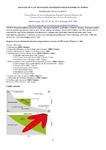Response of wave-dominated and mixed-energy barriers to storms
| dc.contributor.author | Masselink, Gerd | |
| dc.contributor.author | van Heteren, S | |
| dc.date.accessioned | 2014-09-02T16:11:26Z | |
| dc.date.available | 2014-09-02T16:11:26Z | |
| dc.date.issued | 2014-06-01 | |
| dc.identifier.issn | 0025-3227 | |
| dc.identifier.issn | 1872-6151 | |
| dc.identifier.uri | http://hdl.handle.net/10026.1/3092 | |
| dc.description | EPSRC funded EP/I035390/1 The full text is under embargo until 15.05.15. | |
| dc.description.abstract |
Wave-dominated and mixed-energy barriers are extremely dynamic landforms, responding to processes operating over a spectrum of time scales, ranging from daily-to-monthly fluctuations related to storm and post-storm conditions, to century-to-millennium-scale evolution driven by relative sea-level change. Two types of storms are of particular relevance: warm-core tropical and cold-core extratropical cyclones. Both are responsible for generating very large waves, highly energetic surf zone dynamics and sediment transport, elevated inshore water levels, and extensive morphological responses. All cyclones are affected by climate change, which governs their frequency, intensity and tracks. Barrier storm response is primarily governed by maximum storm runup and barrier morphology, as conceptualised in Abby Sallenger's Storm Impact Scale model (Sallenger, 2000). This model defines four storm-impact regimes and includes erosive as well as accretionary responses. On the erosion side, the swash regime drives bar and berm flattening; the collision regime is marked by dune scarping and beach lowe̊ the overwash regime leads to dune scouring and channel incision; and the inundation regime may result in barrier destruction. On the deposition side, storm berms and beach ridges may form and accrete in the swash and collision regimes; localised vertical beach and barrier accretion are associated with the collision and overwash regimes; and washover deposition takes place in the overwash and inundation regimes. Site-specific factors play a key role in moderating the morphological response and include storm characteristics (type, duration and track), longshore sediment supply, upwelling-downwelling currents, coastal setting and inner-shelf topography. The response of a barrier to a tropical or extratropical cyclone can, however, not be considered in isolation and has to be appreciated in a longer temporal context involving morphological preconditioning due to antecedent wave and water-level conditions. Additionally, a simple process-response approach of the cause-and-effect type is inappropriate and a more complex conceptual framework, involving thresholds, feedbacks, resilience and vulnerability, will need to be adopted. A useful way to visualise and conceptualise more complex storm behaviours and the longer-term vulnerability of barriers is the 'resilience trajectory', which maps out the changes in barrier geometry (elevation and width) over various time scales, from weeks to years or even longer, and under varying forcing conditions, including changes in storminess and sea-level rise.An increased understanding of barrier response to storms and sequences of storms is required to better quantify long-term barrier response to climate change. High-resolution and comprehensive decadal records of barrier response to storms are a prerequisite to achieve this ambition, linking site-specific coastal settings, hydrodynamic drivers and morphological responses, and allowing the recognition of recovery- and impact-dominated phases. The enhanced insights in barrier response to extreme events must then be incorporated into improved coastal response models to help predict the impacts of future climate change on wave-dominated and mixed-energy barriers around the world. © 2013 Elsevier B.V. | |
| dc.format.extent | 321-347 | |
| dc.language | en | |
| dc.language.iso | en | |
| dc.publisher | Elsevier BV | |
| dc.subject | beaches | |
| dc.subject | dunes | |
| dc.subject | barriers | |
| dc.subject | overwash | |
| dc.subject | storms | |
| dc.subject | cyclones | |
| dc.subject | coastal response | |
| dc.subject | sea-level rise | |
| dc.title | Response of wave-dominated and mixed-energy barriers to storms | |
| dc.type | journal-article | |
| dc.type | Article | |
| plymouth.author-url | https://www.webofscience.com/api/gateway?GWVersion=2&SrcApp=PARTNER_APP&SrcAuth=LinksAMR&KeyUT=WOS:000338802700015&DestLinkType=FullRecord&DestApp=ALL_WOS&UsrCustomerID=11bb513d99f797142bcfeffcc58ea008 | |
| plymouth.volume | 352 | |
| plymouth.publication-status | Published | |
| plymouth.journal | MARINE GEOLOGY | |
| dc.identifier.doi | 10.1016/j.margeo.2013.11.004 | |
| plymouth.organisational-group | /Plymouth | |
| plymouth.organisational-group | /Plymouth/Faculty of Science and Engineering | |
| plymouth.organisational-group | /Plymouth/Faculty of Science and Engineering/School of Biological and Marine Sciences | |
| plymouth.organisational-group | /Plymouth/REF 2021 Researchers by UoA | |
| plymouth.organisational-group | /Plymouth/REF 2021 Researchers by UoA/UoA07 Earth Systems and Environmental Sciences | |
| plymouth.organisational-group | /Plymouth/Research Groups | |
| plymouth.organisational-group | /Plymouth/Research Groups/Marine Institute | |
| plymouth.organisational-group | /Plymouth/Users by role | |
| plymouth.organisational-group | /Plymouth/Users by role/Academics | |
| plymouth.organisational-group | /Plymouth/Users by role/Researchers in ResearchFish submission | |
| dc.identifier.eissn | 1872-6151 | |
| dc.rights.embargoperiod | Not known | |
| rioxxterms.versionofrecord | 10.1016/j.margeo.2013.11.004 | |
| rioxxterms.licenseref.uri | http://www.rioxx.net/licenses/all-rights-reserved | |
| rioxxterms.type | Journal Article/Review | |
| plymouth.funder | Impact of sequence of extreme storms during 2013/14 winter on southwest coast of England::NERC | |
| plymouth.funder | Impact of sequence of extreme storms during 2013/14 winter on southwest coast of England::NERC |


